FIGURE 1.
Underlying mechanisms of multisystem inflammatory syndrome in children. (A,B) The binding of SARS-CoV-2 spike protein to ACE2 receptors on respiratory epithelial cells leads to its cell entry and viral genome replication via RNA-dependent RNA polymerase (RdRP). Membrane-bound immunologic receptors and downstream signaling pathways mediate the pro-inflammatory response resulting in cytokine storm through the infiltration of neutrophils and macrophages into the lung tissue. (C) SARS-CoV-2 viral genomic ssRNA or other RNA compositions may act as PAMPs and bind to TLRs and RLRs, leading to the activation of IRF3, NF-κB, MAPK/ERK, AP-1, and JNK signaling pathways and secretion of IL-6, IL-8, TNF-α, and IFN-I. (D) Cytokines produced by macrophages, neutrophils, and dendritic cells cause T cell–dependent activation of B cells and production of antibodies and autoantibodies (e.g., anti-endoglin). (E) Neutrophils can form NETs, which are released subsequent to the rupture of the plasma membrane. NETs, IL-6, IL-8, TNF-α, and PAI-1 induce endothelial damage and thrombosis. (F) Cytokine storm, autoantibodies, and activation of immune cells lead to multiple organ damage, including the lungs, brain (e.g., cellular edema of neurons), heart (e.g., acute viral myocarditis), and kidneys (e.g., acute kidney injury).

